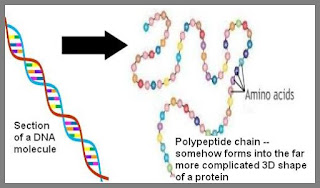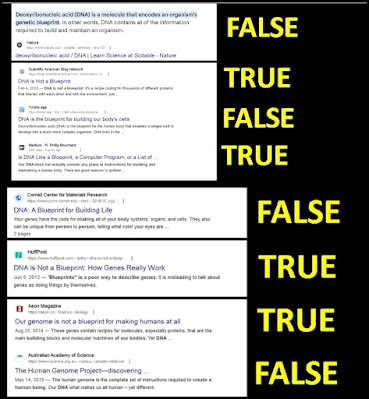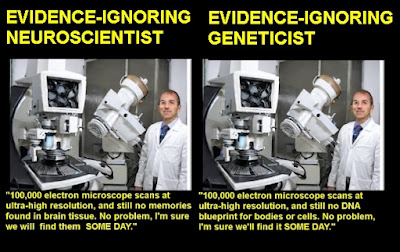Ever since the discovery of DNA and the genetic code in the middle of the twentieth century, many scientists have been making an untrue claim about DNA: the claim that DNA is some kind of blueprint or program or recipe for making a human body.
There are various ways in which this false idea is stated, all equally false:
- Many described DNA or the genome as a blueprint for an organism.
- Many said DNA or the genome is a recipe for making an organism.
- Many said DNA or the genome is a program for building an organism, making an analogy to a computer program.
- Many claimed that DNA or genomes specify the anatomy of an organism.
- Many claimed that genotypes (the DNA in organisms) specify phenotypes (the observable characteristics of an organism).
- Many claimed that genotypes (the DNA in organisms) "map" phenotypes (the observable characteristics of an organism) or "map to" phenotypes.
- Many claimed that DNA contains "all the instructions needed to make an organism."
- Many claimed that there is a "genetic architecture" for an organism's body or some fraction of that body.
- Using a little equation, many claimed that a "genotype plus the environment equals the phenotype," a formulation as false as the preceding statements, since we know of nothing in the environment that would cause phenotypes to arise from genotypes that do not specify such phenotypes.
Judging from the facts, we must conclude that while DNA uses a code of symbolic representations (the genetic code), DNA is not a blueprint for making a human, is not a recipe for making a human, and is not a program or algorithm for making a human. The facts indicate that DNA is not anything close to a complete specification of an organism, but that DNA is instead something much simpler, mainly just a kind of database (or a collection of ingredient lists) used in making particular parts of an organism.
| Type of information | Can it be specified in DNA? |
| Linear amino acid sequence of a protein molecule | Yes |
| Three-dimensional shape of a protein molecule | No |
| Exact location where a protein is located in body | No |
| Layout of a cell organelle | No |
| Layout of a cell | No |
| Layout of a tissue type | No |
| Layout of an organ | No |
| Layout of an organ system | No |
| Layout of a full body plan | No |
| Structure progression from simplest tiniest form to fully grown form | No |
| Dynamic behavior inside an organism during a particular month or year | No |
| MINIATURE LANGUAGES | |||
| NAME | LIST OF WORDS IN LANGUAGE | WHAT CAN BE SPECIFIED BY LANGUAGE | WHAT CANNOT BE SPECIFIED BY LANGUAGE |
| Sandwich Language | Bread, Turkey, Ham, Cheese, Lettuce, Tomato, Onion, Bacon | Various types of sandwiches | Anything that is not a sandwich |
| Exercise Language | Jump, Crouch, Stretch, Punch, Lift, Bend, Squat, Spin | Various types of exercises | Anything that is not an exercise |
| DNA Language | Alanine, Asparagine, Aspartic acid, Arginine, Cysteine, Glutamine, Glycine, Glutamic acid, Histidine, Isoleucine, Lysine,Leucine, Phenylalanine, Methionine, Serine, Proline, Tryptophan,Threonine, Tyrosine, Valine | Polypeptide sequences – a linear one-dimensional sequence of amino acids | Anything that is not a polypeptide sequence, including the 3D shape of a protein, the shape of any body part, the structure of any organism, or a behavior or instinct. |
- On page 26 of the recent book The Developing Genome, Professor David S. Moore states, "The common belief that there are things inside of us that constitute a set of instructions for building bodies and minds -- things that are analogous to 'blueprints' or 'recipes' -- is undoubtedly false."
- Biologist Rupert Sheldrake says this "DNA only codes for the materials from which the body is constructed: the enzymes, the structural proteins, and so forth," and "There is no evidence that it also codes for the plan, the form, the morphology of the body."
- Describing conclusions of biologist Brian Goodwin, the New York Times says, "While genes may help produce the proteins that make the skeleton or the glue, they do not determine the shape and form of an embryo or an organism."
- Professor Massimo Pigliucci (mainstream author of numerous scientific papers on evolution) has stated that "old-fashioned metaphors like genetic blueprint and genetic programme are not only woefully inadequate but positively misleading."
- Neuroscientist Romain Brette states, "The genome does not encode much except for amino acids."
- In a 2016 scientific paper, three scientists state the following: "It is now clear that the genome does not directly program the organism; the computer program metaphor has misled us...The genome does not function as a master plan or computer program for controlling the organism; the genome is the organism's servant, not its master.
- In the book Mind in Life by Evan Thompson (published by the Belknap Press of Harvard University Press) we read the following on page 180: "The plain truth is that DNA is not a program for building organisms, as several authors have shown in detail (Keller 2000, Lewontin 1993, Moss 2003)."
- Developmental biologist C/H. Waddington stated, "The DNA is not a program or sequentially accessed control over the behavior of the cell."
- Scientists Walker and Davies state this in a scientific paper: "DNA is not a blueprint for an organism; no information is actively processed by DNA alone...DNA is a passive repository for transcription of stored data into RNA, some (but by no means all) of which goes on to be translated into proteins."
- Geneticist Adam Rutherford states that "DNA is not a blueprint," a statement also made by biochemistry professor Keith Fox.
- "The genome is not a blueprint," says Kevin Mitchell, a geneticist and neuroscientist at Trinity College Dublin, noting "it doesn't encode some specific outcome."
- "DNA cannot be seen as the 'blueprint' for life," says Antony Jose, associate professor of cell biology and molecular genetics at the University of Maryland, who says, "It is at best an overlapping and potentially scrambled list of ingredients that is used differently by different cells at different times."
- Sergio Pistoi (a science writer with a PhD in molecular biology) tells us, "DNA is not a blueprint," and tells us, "We do not inherit specific instructions on how to build a cell or an organ."
- Michael Levin (director of a large biology research lab) states that "genomes are not a blueprint for anatomy," and after referring to a "deep puzzle" of how biological forms arise, he gives this example: "Scientists really don’t know what determines the intricate shape and structure of the flatworm’s head."
- Ian Stevenson M.D. stated "Genes alone - which provide instructions for the production of amino acids and proteins -- cannot explain how the proteins produced by their instructions come to have the shape they develop and, ultimately, determine the form of the organisms where they are," and noted that "biologists who have drawn attention to this important gap in our knowledge of form have not been a grouping of mediocrities (Denton, 1986; Goldschmidt, 1952; B. C. Goodwin, 1985, 1988, 1989, 1994; Gottlieb, 1992; Grasse, 1973; E. S. Russell...Sheldrake, 1981; Tauber and Sarkar, 1992; Thompson, 1917/1942)."
- Biologist B.C. Goodwin stated this in 1989: "Since genes make molecules, genetics...does not tell us how the molecules are organized into the dynamic, organized process that is the living organism."
- An article in the journal Nature states this: "The manner in which bodies and tissues take form remains 'one of the most important, and still poorly understood, questions of our time', says developmental biologist Amy Shyer, who studies morphogenesis at the Rockefeller University in New York City."
- Timothy Saunders, a developmental biologist at the National University of Singapore says, "Fundamentally, we have a poor understanding of how any internal organ forms.”
- On the web site of the well-known biologist Denis Noble, we read that "the whole idea that genes contain the recipe or the program of life is absurd, according to Noble," and that we should understand DNA "not so much as a recipe or a program, but rather as a database that is used by the tissues and organs in order to make the proteins which they need."
- A paper by Stuart A. Newman (a professor of cell biology and anatomy) discussing at length the work of scientists trying to evoke "self-organization" as an explanation for morphogenesis states that "public lectures by principals of the field contain confidently asserted, but similarly oversimplified or misleading treatments," and says that "these analogies...give the false impression that there has been more progress in understanding embryonic development than there truly has been." Referring to scientists moving from one bunk explanation of morphogenesis to another bunk explanation, the paper concludes by stating, "It would be unfortunate if we find ourselves having emerged from a period of misconceived genetic program metaphors only to land in a brave new world captivated by equally misguided ones about self-organization."
- Referring to claims there is a program for building organisms in DNA, biochemist F. M. Harold stated "reflection on the findings with morphologically aberrant mutants suggests that the metaphor of a genetic program is misleading." Referring to self-organization (a vague phrase sometimes used to try to explain morphogenesis), he says, "self-organization remains nearly as mysterious as it was a century ago, a subject in search of a paradigm."
- Writing in the leading journal Cell, biologists Marc Kirschner, John Gerhart and Tim Mitchison stated, "The genotype, however deeply we analyze it, cannot be predictive of the actual phenotype, but can only provide knowledge of the universe of possible phenotypes." That's equivalent to saying that DNA does not specify visible biological structures, but merely limits what structures an organism can have (just as a building parts list merely limits what structures can be made from the set of parts).
- At the Stack Exchange expert answers site, someone posted a question asking which parts of a genome specify how to make a cell (he wanted to write a program that would sketch out a cell based on DNA inputs). An unidentified expert stated that it is "not correct" that DNA is a blueprint that describes an organism, and that "DNA is not a blueprint because DNA does not have instructions for how to build a cell." No one contradicted this expert's claim, even though the site allows any of its experts to reply.
- A paper co-authored by a chemistry professor (Jesper Hoffmeyer) tells us this: "Ontogenetic 'information,' whether about the structure of the organism or about its behavior, does not exist as such in the genes or in the environment, but is constructed in a given developmental context, as critically emphasized, for example, by Lewotin (1982) and Oyama (1985)."
- Biologist Steven Rose has stated, "DNA is not a blueprint, and the four dimensions of life (three of space, one of time) cannot be read off from its one-dimensional strand."
- Jonathan Latham has a master's degree in Crop Genetics and a PhD in virology. In his essay “Genetics Is Giving Way to a New Science of Life,” a long essay well worth a read, Latham exposes many of the myths about DNA. Referring to "the mythologizing of DNA," he says that "DNA is not a master controller," and asks, "How is it that, if organisms are the principal objects of biological study, and the standard explanation of their origin and operation is so scientifically weak that it has to award DNA imaginary superpowers of 'expression'” and 'control' to paper over the cracks, have scientists nevertheless clung to it?"
- An interesting 2006 paper by six medical authorities and scientists tells us that "biochemistry cannot provide the spatial information needed to explain morphogenesis," that "supracellular morphogenesis is mysterious," and that "nobody seems to understand the origin of biological and cellular order," contrary to claims that such order arises from a reading of a specification in DNA.
- Keith Baverstock (with a PhD in chemical kinetics) has stated "genes are like the merchants that provide the necessary materials to build a house: they are neither the architect, nor the builder but, without them, the house cannot be built," and that "genes are neither the formal cause (the blueprint), nor the efficient cause (the builder) of the cell, nor of the organism."
- Evolutionary biologist Richard Lewontin stated, "DNA is not self-reproducing; second, it makes nothing; and third, organisms are not determined by it." Noting that "the more accurate description of the role of DNA is that it bears information that is read by the cell machinery," Lewontin lamented the "evangelical enthusiasm" of those who "fetishized DNA" and misspoke so that "DNA as information bearer is transmogrified into DNA as blueprint, as plan, as master plan, as master molecule." In another work he stated "the information in DNA sequences is insufficient to specify even a folded protein, not to speak of an entire organism." This was correct: DNA does not even specify the 3D shapes of proteins, but merely their sequence of amino acids.
- In 2022 developmental biologist Claudio D. Stern first noted, "All cells in an organism have the same genetic information yet they generate often huge complexity as they diversify in the appropriate locations at the correct time and generate form and pattern as well as an array of identities, dynamic behaviours and functions." In his next sentence he stated, "The key quest is to find the 'computer program' that contains the instructions to build an organism, and the mechanisms responsible for its evolution over longer periods." Since this was written long after the Human Genome Project had been completed, he thereby suggested that no such instruction program had yet been discovered in the genome (DNA).
- As soon as DNA and the genetic code were discovered, around the middle of the twentieth century very many scientists started to tell a wholly unjustified lie that DNA was a blueprint or recipe or program for making the human body. Nothing had been discovered that justified any such claim. The code used by DNA (the genetic code) is something capable of expressing only low-level chemical information, not any high-level structural information.
- The lie that DNA is a body blueprint continued to be told by many scientists throughout the rest of the 20th century. During the last decade of that century, the Human Genome Project was busy making a complete list of all the genes in DNA.
- When the Human Genome Project completed in 2001, very many scientists continued to make the false claim that DNA is a blueprint for making a human, even though no evidence supporting such a claim had been found by this gigantic effort analyzing the contents of DNA.
- Despite all these claims, by now many scientists have confessed that neither DNA (the genome) nor its genes are any such thing as a blueprint or recipe or program for making a human body, and in February 2024 the leading science journal Nature had an article entitled "It's time to admit that genes are not the blueprint of life," contrary to its numerous previous claims that genes are such a blueprint.
- "I was all ready to marry Willy because I thought he was someone who would be devoted to me for the rest of my life. But I just learned he's been having a sex affair with his co-worker, so all bets are off."
- "I was going to invest many thousands in New Shiny Tech, Inc. But I just learned that their profit and loss statement is bogus, so now all bets are off."
- "I was set to buy that house on Maple Street, but the inspection report shows the foundation is all rotting, and that the pipes are all leaking inside the walls. So now all bets are off."





No comments:
Post a Comment